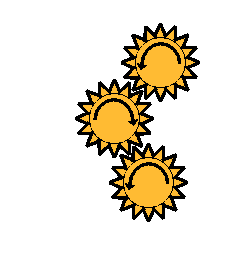Idler Gear: Difference between revisions
From DT Online
m (Changed image) |
mNo edit summary |
||
| Line 1: | Line 1: | ||
[ | Multiple gears can be connected together with one or more [https://en.wikipedia.org/wiki/Gear_ratio#Idler_gears '''Idler Gears''']. | ||
If there are an odd number of gears, the output rotation will be the same direction as the input. If there are an even number, the output will rotate in the opposite direction to the input. | If there are an odd number of gears, the output rotation will be the same direction as the input. If there are an even number, the output will rotate in the opposite direction to the input. | ||
[[File:g2.gif |300px|right]] | |||
<span style="color: green">'''Note:''' | <span style="color: green">'''Note 1:''' | ||
Neither the number of idler gears nor the number of teeth on each idler gear affect the overall '''[[Velocity Ratio]]''' or '''[[Mechanical Advantage]]''' which are both governed purely by the number of teeth on the first '''driver''' gear and last '''driven''' gear. | Neither the number of idler gears nor the number of teeth on each idler gear affect the overall '''[[Velocity Ratio]]''' or '''[[Mechanical Advantage]]''' which are both governed purely by the number of teeth on the first '''driver''' gear and last '''driven''' gear. | ||
</span> | </span> | ||
<span style="color: green">'''Note:''' | <span style="color: green">'''Note 2:''' | ||
If both gears have the same number of teeth, they will rotate at the same speed, however if they have different numbers of teeth then the gear with fewer teeth will rotate more quickly - i.e. the '''[[Velocity Ratio]]''' ''(or [https://en.wikipedia.org/wiki/Gear_ratio ‘Gear Ratio’])'' of a pair of meshing gears is given as the ''Number of Teeth of the Driver Gear divided by the Number of Teeth'' of the Driven Gear. The '''[[Mechanical Advantage]]''' ''(or [https://en.wikipedia.org/wiki/Torque ‘Torque Ratio’])'' similarly is given as ''No. of Teeth on Driven divided by No. of Teeth on Driver''. | If both gears have the same number of teeth, they will rotate at the same speed, however if they have different numbers of teeth then the gear with fewer teeth will rotate more quickly - i.e. the '''[[Velocity Ratio]]''' ''(or [https://en.wikipedia.org/wiki/Gear_ratio ‘Gear Ratio’])'' of a pair of meshing gears is given as the ''Number of Teeth of the Driver Gear divided by the Number of Teeth'' of the Driven Gear. The '''[[Mechanical Advantage]]''' ''(or [https://en.wikipedia.org/wiki/Torque ‘Torque Ratio’])'' similarly is given as ''No. of Teeth on Driven divided by No. of Teeth on Driver''. | ||
</span> | </span> | ||
Revision as of 09:43, 19 April 2016
Multiple gears can be connected together with one or more Idler Gears.
If there are an odd number of gears, the output rotation will be the same direction as the input. If there are an even number, the output will rotate in the opposite direction to the input.
Note 1:
Neither the number of idler gears nor the number of teeth on each idler gear affect the overall Velocity Ratio or Mechanical Advantage which are both governed purely by the number of teeth on the first driver gear and last driven gear.
Note 2:
If both gears have the same number of teeth, they will rotate at the same speed, however if they have different numbers of teeth then the gear with fewer teeth will rotate more quickly - i.e. the Velocity Ratio (or ‘Gear Ratio’) of a pair of meshing gears is given as the Number of Teeth of the Driver Gear divided by the Number of Teeth of the Driven Gear. The Mechanical Advantage (or ‘Torque Ratio’) similarly is given as No. of Teeth on Driven divided by No. of Teeth on Driver.
